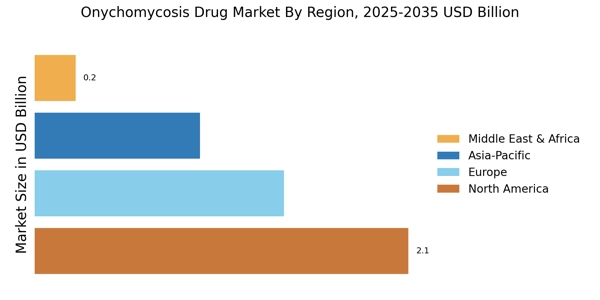Growing Awareness and Education
Increased awareness and education regarding onychomycosis are driving the Onychomycosis Drug Market. Healthcare professionals are emphasizing the importance of early diagnosis and treatment, which is crucial for preventing complications associated with the condition. Public health campaigns aimed at educating individuals about the symptoms and risks of onychomycosis are gaining traction, leading to higher rates of diagnosis and treatment initiation. This heightened awareness is likely to result in a greater number of patients seeking antifungal therapies, thereby expanding the market. Additionally, as patients become more informed about available treatment options, they may actively engage in discussions with healthcare providers, further propelling market demand.
Rising Incidence of Comorbidities
The increasing prevalence of comorbidities such as diabetes and peripheral vascular disease is influencing the Onychomycosis Drug Market. Individuals with these conditions are at a higher risk of developing onychomycosis, which necessitates effective treatment strategies. The intersection of these health issues creates a substantial patient population that requires specialized antifungal therapies. As healthcare systems adapt to address the needs of patients with multiple health concerns, the demand for targeted treatments for onychomycosis is expected to rise. This trend underscores the importance of developing comprehensive treatment plans that consider the complexities of managing comorbid conditions alongside fungal infections.
Increasing Prevalence of Onychomycosis
The rising incidence of onychomycosis is a pivotal driver for the Onychomycosis Drug Market. Studies indicate that approximately 10% of the population is affected by this fungal infection, with higher rates observed in older adults. The condition is often exacerbated by factors such as diabetes and immunocompromised states, leading to a growing demand for effective treatment options. As awareness of onychomycosis increases, patients are more likely to seek medical advice, thereby propelling the market forward. Furthermore, the aging population is expected to contribute significantly to the prevalence of this condition, suggesting a sustained demand for antifungal therapies in the coming years.
Advancements in Antifungal Drug Development
Innovations in antifungal drug development are transforming the Onychomycosis Drug Market. Recent advancements have led to the introduction of novel antifungal agents that demonstrate enhanced efficacy and reduced side effects compared to traditional treatments. For instance, the development of topical formulations and oral medications that target specific fungal strains has shown promising results in clinical trials. The market is witnessing a shift towards combination therapies that may improve treatment outcomes. As pharmaceutical companies invest in research and development, the availability of new and effective treatment options is likely to stimulate market growth, catering to the diverse needs of patients suffering from onychomycosis.
Expansion of E-commerce and Telehealth Services
The expansion of e-commerce and telehealth services is reshaping the Onychomycosis Drug Market. Patients are increasingly turning to online platforms for consultations and purchasing medications, which enhances accessibility to treatment options. Telehealth services allow for remote consultations, enabling patients to receive timely diagnoses and prescriptions without the need for in-person visits. This trend is particularly beneficial for individuals in remote areas or those with mobility challenges. As e-commerce continues to grow, it is likely to facilitate the distribution of antifungal medications, making them more readily available to a broader audience. This shift in consumer behavior may significantly impact market dynamics, driving growth in the onychomycosis drug sector.


















Leave a Comment